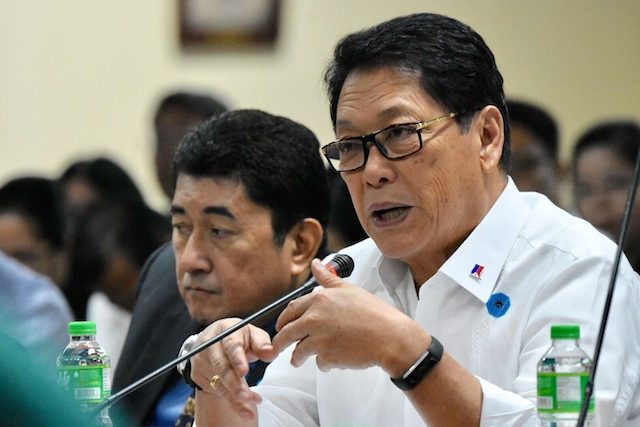SUMMARY
This is AI generated summarization, which may have errors. For context, always refer to the full article.

MANILA, Philippines – Labor Secretary Silvestre Bello III on Thursday, August 30 appealed to lawmakers to increase their budget allocation to hire more labor inspectors across the country.
During the budget hearing at the House of Representatives, Bello said that the department currently has around 800 labor inspectors tasked with examining the compliance to labor laws of 900,000 business establishments.
“We badly need more budget to hire labor law compliance officers if we are expected to implement the labor standards and labor laws. We wanted to hire 2,000 [labor inspectors] but this was turned down by the DBM (Department of Budget and Management),” Bello said in a mix of English and Filipino.
“We need enough funds to hire more labor law compliance officers. We will appreciate if we get that support from Congess,” Bello added.
Under the proposed 2019 national budget, DOLE received a P13.371-billion allocation. The figure is 16.38% higher than its cash-based budget equivalent of P11.489 billion in 2018. (READ: What is cash-based budgeting?)
For next year, budget for personnel services tucked under DOLE’s Office of the Secretary amounts to P2.51 billion. (READ: Budget deadlock: Who’s to blame?)
In April, DOLE released a list of companies employing illegal contracting sevices, topping this list are Jollibee Food Corporation, Dole Philippines, and PLDT Incorporated.
From June 2016 to April 2018, DOLE was able to inspect only 99,526 companies out of the 900,000 establishments nationwide due to manpower constraints.
More inspectors but unfilled vacancies?
Bayan Muna Representative Carlos Zarate acknowledged the need for more labor inspectors, but also pointed out that roughly 15% of the approved regular positions in the department remains unfilled.
In 2017, there were 2,550 approved positions for DOLE, but there were only 2,211 filled positions. In 2018 and 2019, the approved was at 2,651, but only 2,228 were part of the department’s staff.
“Every year, hindi natin nafi-fill up pero pinopondohan for that year. Kulang ng labor law inspection officers, pero bakit hindi filled up ang vacancies?” Zarate asked Bello.
(Every year, we couldn’t fill up [the positions] but we fund it for that year. We lack labor law inspection officers, but why can’t we fill up the vacancies?)
In response, Bello explained that civil service requirements limit them from filling up vacancies.
“There are vacant items because before we fill up these vacant positions, we have to wait for the Civil Service Commission (CSC) on the promotion. It usually takes not less than 6 months,” Bello said.
Contractuals in government
Zarate also pointed out that many employees in the bureaucracy are casual employees under different schemes – job order (JO), contract of service (COS), or memorandum of agreement – that have been with DOLE with over 10 years, but are not regular employees.
There are 228 contractual employees and over 2,000 JO employees in DOLE, according to Zarate.
“The irony of all ironies is that DOLE wants to end endo, but we have a lot of government employees that do not have security of tenure. These employees may have been with the department 5, 10, or 20 years. In other departments, they were there for 30 years already,” Zarate said.
A Joint Circular between the DBM, CSC, and the Commission on Audit (COA) sought to rationalize the bureaucracy, and mandated agencies to review their organizational structure.
Under the circular, JO and COS employees will be prioritized for filling up vacant plantilla positions. But the workers fear the provision that allows the renewal of their employment only until December 31 this year.
By 2019, they will be hired through private agencies – a notorious practice in the private sector.
“Can the Secretary convince the departments (DBM, COA, CSC) to halt the implementation of the circular?” Zarate asked.
But Bello said it is not within his jurisdiction as Labor Secretary.
“I honestly share your sentiments about the situation of our public sector employees. Unfortunately, it is not within my jurisdiction,” Bello said.
Based on the CSC’s 2016 audit of the bureaucracy, there are 2.4 million workers in the national government. One public sector worker attends to 42 Filipinos, pegged at the 100.98 million Philippine population as of August 2016.
The number of JO and COS workers recorded was at 592,162 – nearly a quarter of the whole workforce. They are those hired through a term-based arrangement without benefits and tenure even if many of them have been in government service for at least a decade. – Rappler.com
Add a comment
How does this make you feel?
There are no comments yet. Add your comment to start the conversation.